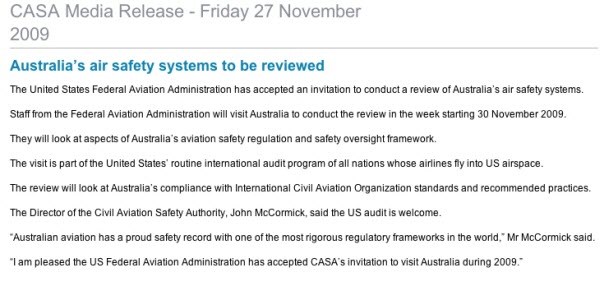The US Federal Aviation Administration audit of airline safety oversight in Australia that CASA welcomed last November has not gone smoothly, and could see this country downgraded by the American agency to the same untrustworthy category as parts of the third world.
In fact the results in November were sufficiently adverse to require further examination by the FAA in this country in coming weeks, this time without the spin evident in the only press release to come from CASA on this topic.
When asked to comment on reports by Washington DC sources that the FAA audit process had found insufficient progress had been made in fixing the deficiencies identified in a damning 2008 audit of Australian safety oversight by ICAO, a CASA spokesperson said:
“The United States Federal Aviation Administration is conducting a review of Australia’s air safety systems. This review began late last year and is continuing.
Representatives from the Federal Aviation Administration visited Australia late last year and are scheduled to visit Australia again soon.
The review is looking at aspects of Australia’s aviation safety regulation and safety oversight framework. It is part of the United States’ routine international audit program of all nations whose airlines fly into US airspace.”
The CASA response doesn’t address the issues.
The original ICAO report, leaked to Crikey last May, found that CASA was under funded, was out of touch with its obligations under international aviation treaties, was incapable of identifying or understanding critical issues involving air safety, and was in part reliant on staff who were inadequately trained or otherwise incapable of dealing with key safety compliance matters.
As then reported, the final draft of the ICAO audit, the one that was waved around as a rapturous endorsement of Australian safety oversight by the Infrastructure and Transport Minister, Anthony Albanese, was in fact a negotiated summary of satisfactory outcomes that were contingent on extensive remedial work by CASA to a timetable that expired at the end of last year.
The appendices to the report, which outlined the incompetency of CASA, made grim reading, and while some of the ICAO mandated remedies were made as required, the FAA was always going to insist, whether invited or not, on finding out whether the nitty gritty of competent and comprehensive safety oversight had been achieved in full in Australia.
As yesterday’s report on the ATSB failure to prosecute Jetstar for a blatant and determined refusal to comply with the law on reportable safety incidents illustrates, safety compliance and its oversight in Australia is non-existent by US standards.
We’re all flying in the lucky country, and the dice just keeps being rolled, again and again, on safety failures that attract serious penalties in the developed aviation world.
If CASA isn’t as lucky with the FAA as it was with ICAO, and it deems our safety oversight to be diminished, it will be the Australian carriers who are punished, as they will then be blocked from increasing their services to the US until their regulatory oversight is upgraded, and their flights and ground operations will come under ‘enhanced’ surveillance in America.
They will also, inevitably, be labelled in the US media, as less safe than US carriers.









Given that Qantas received a once in a lifetime free kick with the quote in the movie “Rain Man” about Qantas being the safest airline in the world (you cannot buy that sort of publicity) it is almost criminal that the airlines safety standards have been left to slip so badly.
The blame lies partly with management who are willing to risk the destruction of their reputations for safety, and partly on a safety regulator who fails the safety test and refuses to regulate.